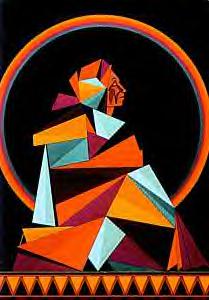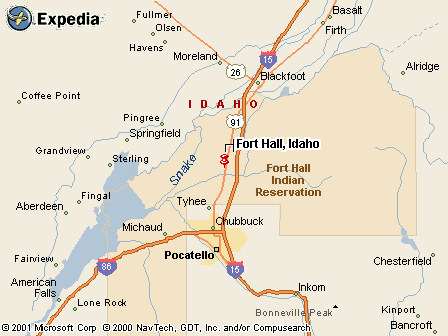|
|
Canku Ota |
|
|
(Many Paths) |
||
|
An Online Newsletter Celebrating Native America |
||
|
August 11, 2001 - Issue 42 |
||
|
|
||
|
Through the Eyes of an Elder |
||
|
by Emily Jones, Journal Writer-July 29, 2001 |
||
|
Old Age Brings Visions of Rainbows by Helen Hardin |
 FORT HALL,
ID — Sitting and breathing in the fresh air at the Fort Hall festival grounds, Layton Little John has the serious,
knowing look of a man who has seen and has been involved in many things. FORT HALL,
ID — Sitting and breathing in the fresh air at the Fort Hall festival grounds, Layton Little John has the serious,
knowing look of a man who has seen and has been involved in many things.Little John’s life now spans 75 years. He might move a little slower than he did as a young man, but it’s with an air of experience and wisdom. And he speaks slowly, coming from a tradition in which the spoken word is important, sacred. He speaks carefully. He has lived his entire life caught between two worlds: the traditional American Indian culture of his parents and grandparents, and the white culture that begins just a few miles from his home on the boundary of the Fort Hall Reservation. Growing up on the reservation, the Bannock Indian says he spent his boyhood learning about his people. He listened to stories from people like his father, John Little John, a scout in the Nez Perce War. Similarly, he has told stories of his own life to his children and grandchildren. The Bannock people, his grandmother told him, were moved to the reservation without a signed treaty. “We’re the tribe that never surrendered,” he says. Little John has dealt with the white world since he was young, too. He worked as an interpreter for white people in the 1930s. And he was there when land for the Pocatello Airport was taken from the reservation for use during World War II. The land was ceded, Little John says, because the military told the tribes it was needed for the war effort. But after the war, the airport was sold by the federal government to the city of Pocatello for one dollar. Although years have passed, the anger over the lost land remains with Little John and many tribal members. “I attended the meeting,” Little John says. “I heard him say when there was no more emergency, it would be returned to the tribe.” It was in the white world that Little John fought in the Normandy Invasion during World War II. And later, he worked with U.S. Sen. Frank Church. Little John still keeps an eye on politics and he says now that he wants to work to ensure all veterans are recognized for their commitment. “I want the Indians to be represented,” he says. “I want everyone, Indians and non-Indians, to be represented. I have to do something.” He’s long been involved in reservation politics as well. In the 1950s, Little John helped build the current festival grounds, where the annual Shoshone-Bannock festival is held — a weeklong event that now attracts thousands of visitors every August. Shirley Kaiyou, a good friend of Little John’s, remembers seeing him at political meetings she attended with her grandmother when she was a child. Little John was once the chairman of the Tribal Business Council, and there was a time when meetings were much more exciting than they are now, Kaiyou says. “They were really radical,” she says. “Now they are much calmer. They speak English and they’re educated.” Kaiyou and Little John spend a lot of time discussing politics. They talk about trust fund issues, and the history of the tribes. “Mostly we converse in our Bannock language about things,” Kaiyou says. “We talk about funny things, too.” In many ways, the Fort Hall of Little John’s youth is the same as today, but the outside world has had an influence in many ways. For instance members may hold onto traditional beliefs while embracing new computer technology. When general elections were conducted in May, the tribal members met as a group to watch the vote count, just as they always have. Rather than gathering around a person counting, however, they gathered around a vote-counting machine. |
|
|
|
Shoshone Bannock Tribal Enterprises |
|
Fort Hall |
|
|
||
|
|
||
| Canku Ota is a free Newsletter celebrating Native America, its traditions and accomplishments . We do not provide subscriber or visitor names to anyone. Some articles presented in Canku Ota may contain copyright material. We have received appropriate permissions for republishing any articles. Material appearing here is distributed without profit or monetary gain to those who have expressed an interest. This is in accordance with Title 17 U.S.C. section 107. | ||
|
Canku Ota is a copyright © 2000, 2001 of Vicki Lockard and Paul Barry. |
||
|
|
|
|
|
The "Canku Ota - A Newsletter Celebrating Native America" web site and its design is the |
||
|
Copyright © 1999, 2000, 2001 of Paul C. Barry. |
||
|
All Rights Reserved. |
||

